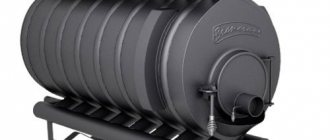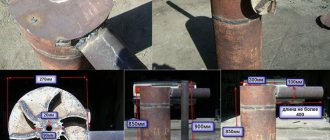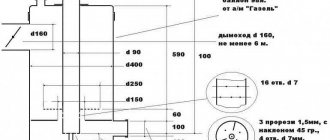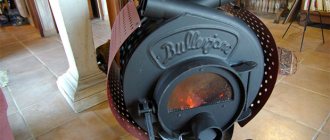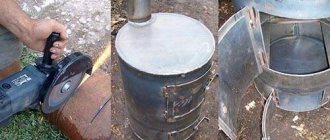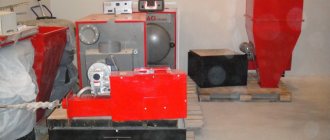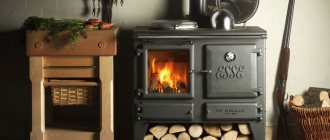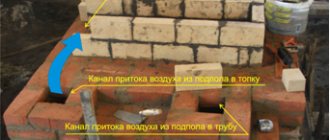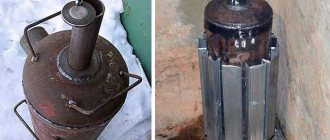Wood heating stoves TMF Fire-battery – long-burning stoves
For wood to burn, air is needed. To burn strongly, you need a lot of air; to smolder slowly, you need a little air leak. In the TMF Fire-Battery stove you can regulate the air flow from maximum during ignition to minimum in economical combustion mode by changing the positions of the fine adjustment valve and gate.
- Door . The rotating mechanism of the handle reliably fixes the door in the closed position, and the seal ensures reliable pressing of the door to the oven body. The door has a size of 15-30 cm and opens to an angle of 120°, which allows you to conveniently load the stove with firewood to the very top.
- Ash box . Fire-battery stoves have a sealed ash box. When switching to an economical combustion mode, it slides into the ash pan and “snaps” onto the protrusion. The seal on the front wall of the ash drawer ensures that it is tightly closed.
- Fine adjustment valve . Located under the firebox door. A fine adjustment valve is necessary to supply air to the firebox during long-burning mode, when both the door and the ash drawer are tightly closed. The valve position adjustment is stepless and allows you to select any combustion mode - from intense to complete extinguishing of the stove.
- Shiber . A damper is a damper at the chimney outlet to regulate the draft in the chimney. Its free rotation is prevented by the fixed positions of the handle. Even in a completely closed position, the chimney is not completely blocked by the damper; it remains possible to create minimal draft.
Termofor Fire-battery 7
Alexey, 11/20/2017
Advantages: Appearance, ease of kindling, compactness, light weight, large firebox
Disadvantages: What I understood about this stove are rather its features: 1) It is very important to clean the chimney regularly (if you heat it constantly, then several times a season). For this, it is useful to exit through a tee and think about how you will climb onto the roof. If everything was fine with you before, but after some time the stove began to smoke, it’s time to clean the chimney 2) The stove may leak condensation. It is better not to use mono pipes (only for the first meter) - they are collected by smoke and, in addition to being supercooled, condensation will also flow through the cracks from the outside. To avoid problems, the pipes are only a sandwich and the outlet is through a tee, it doesn’t matter whether the pipe comes out through the wall or into the ceiling. The sandwich inside collects condensation and there will be no leaks and less cooling, and the tee will provide easy access for cleaning. 3) It’s better not to block the damper at all - regulate it only by inflow 4) When loading a new portion of firewood, you must first open the door a little and, after waiting for the draft to appear, open the door completely and load. 5) And most importantly, never overheat the oven! To do this, monitor the intensity of combustion. Do not operate for a long time with the blower open or with the fine tuning set as open as possible, in order to warm up the room faster. In short, monitor the flame through the glass and change the inflow settings. If you overheat, the seams will burn out or come apart.
Comment: I was looking for a stove with an outlet through the wall. It turned out to be the cheapest. Just 3 meters of pipe and the draft is like a beast, the stove is humming with the vent slightly open! In this mode, I only light at the beginning to get the first batch of coals and warm up the chimney. Then I close the vent and use only the fine-tuning knob - I open it as much as possible when I have loaded the firebox full and let the fresh wood burn for 5-10 minutes, then I close it halfway if I need it warmer, or I close it almost completely if the house is already warmed up and I need long-term burning. The stove does not smoke - a little smoke enters the room only when I load a new portion of firewood and it begins to burn strongly when the door is open. My gate is always open to the maximum. A 180 cubic meter house (6x7, two floors) fully warms up in 5 hours if it is -10 outside. Regarding the burner, it does not fit completely; if the room is dark, I can see the fire through a gap of less than 1 mm, but it never smokes. The handle doesn't get hot at all. I can always open the door with my bare hand. As for the glass, it smokes a little, but the fire is visible. How beautiful she is! All the same, I would give 10 points out of 5 for the design. And also, I took the OB7 because the small dimensions were important to me. If there is room, then take OB9, because Any length of firewood will fit there and in smoldering mode the power will be greater. And the difference in price is small.
Fire-battery stove = Fire-battery stove
Heating stove Fire-battery is also a stove for cooking. Even if the electricity is turned off, the TMF Fire-battery stove will warm you, feed you and give you something to drink. On the top surface of the firebox there is a cast iron burner with two rings of different diameters for cookware of different sizes. Through this window you can add firewood to the firebox and clean the upper part of the stove from soot.
Fire-battery Light models do not have cast iron burners. The upper surface of Fire-Battery Light stoves can only be used for heating food (read about Fire-Battery Light stoves below).
Fire-battery with water circuit
The presence of the letter “B” in the name of the modification of the Fire-Battery stove (for example, the Fire-Battery stove 9B) means the presence of a heat exchanger tank inside the firebox of the stove. It is designed to heat water for domestic needs. The heat exchanger itself has a small volume of 1.3 liters, but is capable of heating water in an attached remote tank with a volume of up to 100 liters. To do this, the remote tank and heat exchanger must be connected by pipes; fittings for connecting the water heating system protrude on the rear wall of the furnace (external thread G3/4). The principle of operation of the heat exchanger tank is based on the physical properties of hot water to rise and cold water to fall. Thus, by creating the opportunity for water circulation in the heating system, the water in the remote tank gradually heats up, and you have the opportunity to wash or wash yourself with hot water.
The article “All about heat exchangers” talks in detail about the nuances, dimensions and precautions when installing a water heating system using a heat exchanger built into the furnace.
Ease of installation and operation of heating stoves TMF Fire-battery
Cooking and heating water using a heating stove is, of course, good, you say. “But first you need to install it, then heat it every day, and also clean it periodically. We did everything to make it easy and convenient!
- The universal chimney outlet allows the chimney to be led both upward and backward. Note! Fire-battery Light stoves (see below) have only one option for the chimney outlet - up.
- The large vertically oriented firebox door allows you to conveniently fill the stove with wood to the very top.
- A spacious firebox allows you to fill the stove with the maximum amount of firewood for long continuous burning.
- The door has a translucent screen made of heat-resistant glass "SCHOTT ROBAX". It doesn’t just give the stove a sophisticated look. Through this window it is convenient to control the combustion process. The glass is self-cleaning.
- The well-thought-out geometry of the firebox eliminates the accumulation of unburnt fuel, which gradually falls onto the grate under the influence of gravity.
- Replaceable protection protects the firebox from burning out in places where hot coals accumulate. If necessary, the protection can be easily changed to a new one at home.
- To remove ash from the ash drawer, you do not need to turn the drawer over, just tilt it like a dustpan. Easy and convenient!
Heating stove TMF Fire-battery Characteristics and dimensions
A table is the best way to organize data. Ask Mendeleev, he will confirm. Therefore, we have collected for you in one table all the characteristics of Fire-battery stoves, see:
| Model Fire-battery | 5 | 5 B | 7 | 7B | 9 | 9B | 11 | 11B |
| Type of fuel | Firewood, peat briquettes, pellets, wood chip briquettes for closed type heaters | |||||||
| Volume of heated room, max. | 100 cu. m | 150 cu. m | 200 cu. m | 250 cc m | ||||
| Rated power | 6 kW | 10 kW | 13 kW | 16 kW | ||||
| Width | 37 cm | |||||||
| Depth | 55.5 cm | 68 cm | 80.5 cm | 93 cm | ||||
| Height | 76 cm | |||||||
| Weight | 42 kg | 44 kg | 52 kg | 54 kg | 60 kg | 63 kg | 72 kg | 75 kg |
| Fire door opening | 15*30 cm | |||||||
| Log length, max | 29.5 cm | 27.5 cm | 42 cm | 40 cm | 54.5 cm | 52.5 cm | 67 cm | 65 cm |
| Combustion chamber volume | 35 l | 32 l | 47 l | 45 l | 62 l | 59 l | 76 l | 73 l |
| Fuel loading volume, max. | 30 l | 27 l | 42 l | 40 l | 57 l | 54 l | 71 l | 68 l |
| Chimney diameter | 120 mm | |||||||
| Recommended chimney height | 5 m | |||||||
| Heat exchanger tank volume | — | 1.3 l | — | 1.3 l | — | 1.3 l | — | 1.3 l |
Oven TMF Fire-battery LIGHT
“Any whim for your money” is what they say nowadays. But if you are not a capricious blonde, you can save on those conveniences of a heating stove that you do not need. The construction and design were simplified as much as possible while still leaving a beautiful heating stove, equipped with a large sealed firebox and a high door; The stove, which is distinguished by excellent heating technology and fine combustion control, provides the ability to heat water and warm up food. The cast iron burners and rotary chimney outlet, glazing and convector on the door were removed. They still left replaceable protection for the firebox against burnout - let the Fire-battery stove last longer.
Thus, all technical characteristics of the Fire-battery Light model can be viewed in the table above. And here is another small table for comparing prices:
| Standard version | LIGHT package | ||
| Oven Fire-battery 5 | RUB 15,709 | Oven Fire-battery LITE 5 | RUB 13,639 |
| Oven Fire-battery 5B | RUB 18,889 | Oven Fire-battery LIGHT 5B | RUB 16,499 |
| Oven Fire-battery 7 | RUB 17,719 | Oven Fire-battery LITE 7 | RUB 15,649 |
| Oven Fire-battery 7B | RUB 20,899 | Oven Fire-battery LIGHT 7B | RUB 18,499 |
| Oven Fire-battery 9 | RUB 19,739 | Oven Fire-battery LITE 9 | RUB 17,659 |
| Oven Fire-battery 9B | RUB 22,919 | Oven Fire-battery LIGHT 9B | RUB 20,499 |
| Oven Fire-battery 11 | RUB 21,749 | Oven Fire-battery LITE 11 | RUB 19,669 |
| Oven Fire-battery 11B | RUB 24,919 | Oven Fire-battery LIGHT 11B | RUB 22,499 |
Ford Bronco Bronchitis F350 › Logbook › Heating in the garage. Fire Battery 7 lite. Termofor.

There were diesel and gas and electric transformers... but I never used a wood-burning one in a garage. I weighed and thought about it for quite some time. I read storytellers on the forum house. Ultimately, it is what it is. Termoforovskaya Fire Battery 7 light.
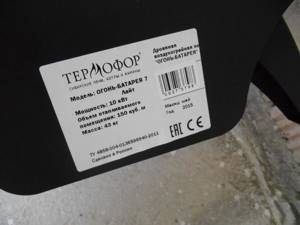
Ideally, under ideal conditions, etc., for 150 cubic meters. I probably have 120. It is clear that if you fart well enough in an insulated, insulated room, the heat will remain for a very long time. Therefore, I have already taken not 5 but 7 sections. And more logs will climb. 5th is quite small in length.
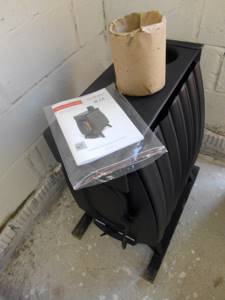
If you look closely, you can see a defect that I didn’t notice in the BRAND store on Signalny. There is no bend on the third gill of the battery. And it’s not that they forgot to bend it, but they stupidly cut it off incorrectly. It seems that I didn’t find any more jambs during inspection, both from the outside and from the inside. If it doesn’t come apart at the seams during combustion, then that’s fine.
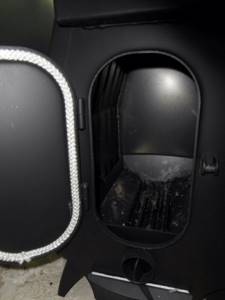
So the rest seems to be done neatly, but it’s not as if it’s fantastic, as advertised on the website. If it had cost 10-12 instead of 14 rubles, then everything would have been completely justified.
They installed it in half a day. For sealant, clamps. We must pay tribute, the branded chimney fits well and the knees fit tightly into each other.
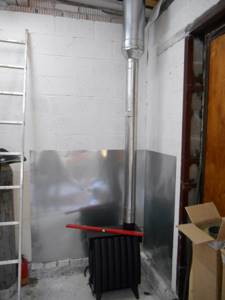
Then I spent half a day cutting up the roof and lubricating it just to be sure))

The photos show the accompanying tools and materials.
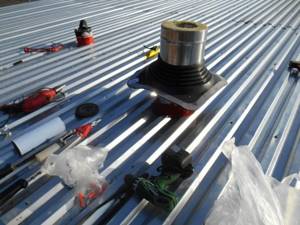
Red is a sub-fire-resistant sealant, which is 300 degrees and short-term 600. (all pipe joints are heat-resistant 1400 degrees). Underneath it, with a clamp, I pulled a rose from the corrugated sheet to the pipe, which I cut with a grinder.
Flash for both rivets and roofing screws. I applied sealant to both before planting. Then more from above. And then I still filled the top with bitumen roofing resin. There are no photos though. it was already dark.
Well, then another sandwich, finishing it and mushroom.
So I didn’t take a photo during the day. I'll add it later.
Before installation, I also placed the reflector behind the stove.
It stood for a couple of days, then heated it with the gate open.
It stank, burning with oil and polymerizing the paint as stated in the instructions. The draft is good, although instead of the recommended 5 meters of chimney it was possible to install only 4.
When it gets colder, we'll see how we can heat it. So far it's not too hot. In any case, when I come to an unheated garage, I turn on the diesel engine, change clothes, light the stove, then turn off the accident and this should keep it warm. But this is in theory. Wait and see.
It's getting cold. The oven began to be used more often. The valve entrance to the stove was constantly moving, the sealant came off, cracked, etc. When you look into the stove, you can see the gaps. Perhaps it even siphoned through it.
It is clear that doing this is not the best option. But the runs at the stove will be mainly along the exhaust lines. Therefore, when replacing the damper, when it burns out, I’ll bluntly cut it off, remove the remains with a stripper, and weld the damper on the removed stove before installation. When the stove in the corner is not convenient to burn out. I hope this will happen in 3-5 years...
Last photo of the kindling. When it returns to normal mode there is little smoke. When the coals appear there is almost no smoke.
